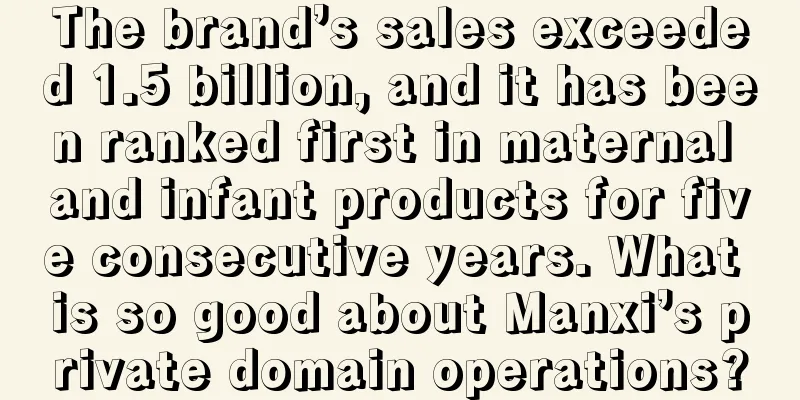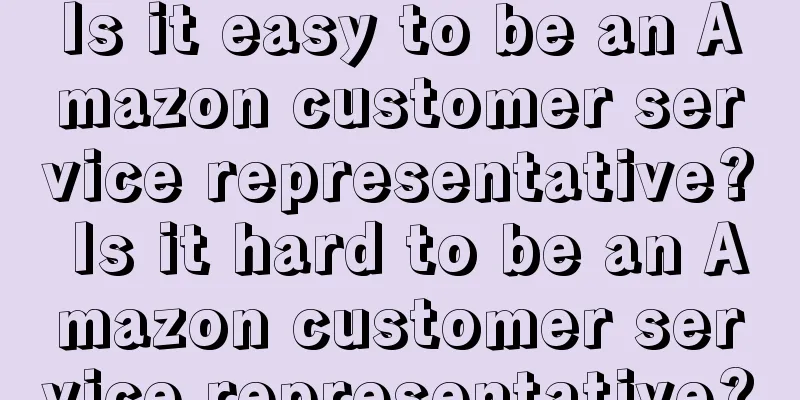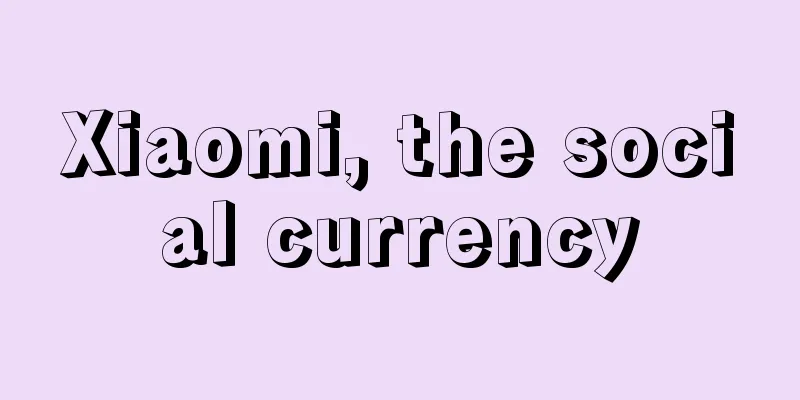“Effect” is more important than “brand”

Many marketers have a sacred feeling for "brand", and believe that the most important thing in running a business is to build a brand. But in fact, this is not the case. We can find that many businesses started by marketers are not successful. The reason behind this is that they ignore many things that are more important than brand, and they are also easily led astray by "brand thinking". I hope that through this article, everyone will rethink the issue of "brand building". Is it really the key to a company's long-term operation? And the more critical question is, is it still necessary for companies to build "brands" at the moment? 1. Branding can be built quicklyFrom a traditional perspective, if companies want to achieve high-value, differentiated growth, they usually need the support of brand power to achieve a strong product premium. But the problem arises again, brand power often requires a long period of accumulation and precipitation by companies, and cannot be built in a short period of time. So isn’t the business world an environment with obvious first-mover advantages and winners take all? Obviously this is not the case, so what went wrong? Various marketing leaders have earnestly told entrepreneurs that brands cannot be built quickly and that they must have a long-term mindset when starting a business. This seems to be a matter of course, but unfortunately, in today's environment, only the second half of the sentence is true. Entrepreneurship certainly requires a belief in long-termism, but this does not mean that companies cannot quickly build brand power and have to use stupid methods to make long-term brand investments. Therefore, many theories and viewpoints of marketing leaders and in marketing textbooks actually have specific applicable scenarios. Maybe they were correct in the past, but may not be suitable today. In the past, brand building was indeed difficult to achieve quickly in many cases. Even if a company quickly gained public recognition in a short period of time, it did not mean that it had strong brand power. For example, the various CCTV bidding winners in the past were only short-lived. At that time, experts often commented on these brands that the company expanded too quickly and overdrew its brand power. It can be seen that the industry generally believes that brand power is difficult to build quickly. Perfect brand growth cases in people's minds may be super brands such as Coca-Cola, McDonald's, and Nike. Coca-Cola was founded in 1886, which is 136 years ago. During its growth, it experienced two world wars and went global with the infiltration of US military supply lines and American culture. It also left a lot of wonderful creativity in the history of marketing; McDonald's was founded in 1955, which is 67 years ago. It not only greatly promoted the standardization of Western food, but also became the childhood memory of many people. In people's impression, it seems that building a brand requires decades of hard work, and there is no other shortcut to contributing a large number of excellent products and wonderful ideas in day-to-day brand operations. We would like to call companies that hold this brand view brand fundamentalism. But let's look at some of the things that have happened in the market in recent years. In the field of sportswear, lululemon was founded in 1998, opened its first offline store in 2000, and made a breakthrough by entering the yoga wear category. It was listed on the Nasdaq in 2007. In the past two years, its market value has surpassed Adidas, making it the second largest sportswear brand in the world. Adidas was founded 49 years earlier than lululemon, which means it has 49 more years of brand accumulation. It can be said that Adidas has maintained a good brand influence and reputation over the years, and has sponsored many players in various competitions. But even so, it has been surpassed. For Chinese users, lululemon only truly entered the Chinese market in 2016. Less than ten years ago, it has been loved and recognized by a large number of middle-class users. Lululemon's brand positioning is mid-to-high-end. According to common sense, mid-to-high-end brands need more long-term brand power to support their product premiums than mass brands. However, lululemon has broken this cognitive stereotype. There are many brands similar to lululemon, such as Canada Goose (although it was founded in 1957, it only officially entered the Chinese market in 2018), allbirds, etc. Some people may say that these are all foreign mid-to-high-end brands. Although we are now talking about national confidence, Chinese people still have more subconscious favorability towards foreign brands, and mid-to-high-end positioning may be an exception. Then let's take a look at the following Chinese local brands: Take Luckin Coffee for example. Despite its history of financial fraud, Luckin is undoubtedly a brand that has promoted the further popularization of freshly ground coffee in China. Luckin's first store opened in October 2017, and in November it hired Tang Wei and Zhang Zhen as brand ambassadors. It submitted an IPO application in 2019, and after the financial fraud incident was exposed, it is now on the right track of business operations. Luckin Coffee has only been around for five years, but it has clearly established itself as a brand. While further expanding into the affordable freshly ground coffee category, it has also had many innovative practices in marketing. If Luckin Coffee is a special case, then Mixue Ice City, which is also in the new tea beverage market, is more convincing. Mixue Ice City was founded in 1997, 25 years ago, but its brand broke out of the sinking market only after the new consumption wave. In 2018, Mixue Bingcheng had a total of over 5,000 stores, and in the first quarter of 2022, the number of stores had exceeded 20,000. Its brand symbols such as Snow King are deeply rooted in the hearts of the people, and its marketing is remarkable. The brand has quickly achieved a position in the public's mind. Chinese companies still have successful brand building cases in foreign markets. SHEIN was founded in October 2008, but it was not until 2012 that it focused on the overseas fashion product market, and it was not until 2014 that the SHEIN brand was officially established. With the flexible supply chain concept of "small orders and quick response", SHEIN has subverted the price and experience of traditional fast fashion. The most talked about thing in the industry is that SHEIN has surpassed the Spanish fashion chain brand ZARA and become the most popular fashion retail brand in the world, and ZARA has been established for 47 years. We can also observe this brand iteration phenomenon from another perspective. As we all know, consumer electronics brands such as Nokia and BlackBerry have fallen behind in the tide of technological iteration in just a few years. Decades of brand asset accumulation and sedimentation have not helped them avoid the fate of decline. In fact, the brand imprint has given them too obvious and outdated cognitive labels. It is hard to say whether it has delayed or accelerated the disappearance of the brand. (Of course, Nokia and BlackBerry have transformed into toB companies, and their brands have not disappeared.) Not to mention the high-tech industry market, even a giant like Coca-Cola, which has been established for more than 100 years, has felt the pressure of the rapid rise of the Yuanqi Forest brand in the Chinese market. What we want to say is that in the face of the great changes of the times, brand accumulation and brand value may not be something that can help companies survive the cycle, and we do not need to deify the brand. At the same time, building a brand does not mean that it must be accumulated through decades of hard work as marketing experts say. We believe that the times have changed, and brands can be built quickly. 2. Brand is not importantFormer Coca-Cola chairman Woodruff once said: "If my factory was destroyed by fire, if I encountered a global financial crisis, as long as I had the Coca-Cola brand, I would stand up again the next day." This statement was later often regarded as a classic sentence to interpret brand power. Because Coca-Cola is so successful, the brand concept of Coca-Cola has become a kind of business consensus. Later, when people analyze successful business cases, they often attribute it to the dimensions that the company attaches importance to brand building and has good brand building. Why is McDonald's so successful? Because they focus on brand building; why is Procter & Gamble so powerful? Because they focus on brand building; why is Apple so successful? Because they focus on brand tone... But in fact, this kind of "brand power attribution" is often just the self-brainwashing of marketers. It happened that I read a book about Coca-Cola in the first half of this year, called "The Coca-Cola Empire: A History of Resource Plunder", and I recommend it to everyone to see the other side of Coca-Cola's development. (If I have more time, I will open this book, it's quite interesting) Simply put, the reason why Coca-Cola has grown from a potion into the super enterprise it is today is not because of its continuous investment in brand building, but because it hit several historical nodes and made several key decisions correctly, especially in supply chain construction and government lobbying, which gave it a strong hard barrier. In addition, it hit the right spot in the destiny of the United States, allowing its products to be sold all over the world. There is a counterintuitive view that, from a certain perspective, Coca-Cola's mass communication and brand favorability building are public relations operations derived from an effort to alleviate the public's negative impressions of its waste of resources, ecological destruction, obesity, etc. At a time when everyone is blaming Coca-Cola for excessive sugar intake and the increase in obesity, Coca-Cola uses its wonderful brand appeal to make the public think that it is a company that provides happiness. Coca-Cola's brand concept is regarded as an orthodoxy, and it has indeed promoted the construction of marketing and brand theory, but whether it is still applicable and whether "brand power" is the primary goal that companies need to pursue, we think it is questionable now. After all, times have changed. So how have times changed? 1. The first is that the speed of product iteration is acceleratingIn the past, the fast-moving consumer goods industry was a typical "channel is king" and market-driven industry. Product strength was not important to a certain extent. As long as the channels could be rolled out quickly and market opportunities could be seized, the products would naturally be sold. In the past, there were two important backgrounds for companies to believe in the strategy of "channel is king". The first was that it was a stage where product supply was in short supply and there was a large amount of product supply and demand asymmetry in the market, so the company's wild expansion could achieve wild growth. The second was that the differences between products were not great before, so the importance of channels was magnified and the importance of brands was weakened. So why were there not many differences between products in the past? The main reason is that the FMCG industry is an industry with a particularly long technology iteration cycle. Unlike high-tech industries such as the Internet, it is not able to quickly iterate products with the help of technological advances. The research and development and upgrade of a biscuit or a shampoo may take several years. It is for this reason that the FMCG industry has produced many classic products that have remained the same for decades. That is to say, in the past, product technology was relatively mature, and companies were playing a business of economies of scale. Only by making the cake bigger could they achieve rapid growth, but making the cake delicious was not so urgent and important. But what has changed now is:
Both of these reasons will drive the emergence of differentiated new products in the fast-moving consumer goods industry. Some of them are the result of the application of new technologies, which has greatly improved the product experience, such as Santonban. Some of them are the result of continuous user testing, which has found the unmet needs of consumers, such as Yuanqi Forest. The emergence of new products and hot-selling products is actually a cross-dimensional attack on traditional brands. If these new products and hot-selling products can achieve continuous repurchase and market penetration, they are likely to quickly erode the market share of traditional enterprises and even subvert traditional brands. This cross-dimensional attack-style commercial competition has almost nothing to do with whether the brand power of traditional enterprises is sufficient or whether the brand building is perfect. 2. The second is the rapid switching of user access channelsE-commerce has a profound impact on corporate marketing channels. Almost all of today's emerging consumer brands originated from e-commerce scenarios. At the same time, the explosion of short videos, live broadcasts, private domains and other scenarios has also given a large number of emerging companies the opportunity to overtake others. Of course, we believe that relying solely on channel dividends cannot form a company's marketing competitiveness, because channel dividends ultimately make money through information asymmetry. As competition continues to intensify, channel dividends gradually fade, which leads to the phenomenon of short-lived Internet celebrity brands that we often mention. But it is important to note that changes in channels actually mean changes in users’ media-catalyzing habits, especially changes in the media-catalyzing habits of emerging young users who have not yet developed brand loyalty. This change is long-term and is something that companies must pay attention to. Let’s take Tesla as an example. Tesla claims to be a company that does not advertise, but its marketing communication can be achieved more efficiently through public relations and social media. Although Tesla’s success is due to its product strength, the emerging user-catalyzed channels such as social media and social KOLs have greatly boosted the company’s communication and penetration. Let’s take Perfect Diary as an example. Although Perfect Diary has not had an easy time in the past two years and its stock price has been falling, it is undeniable that it has indeed snatched away the cosmetics market share of international beauty brands in the short term. The reason behind this is that Perfect Diary has seized the user catalyst channel in the private domain. In fact, if the products themselves are similar, most users are likely to consume them through the most convenient channel rather than buying products of a specific brand. After consuming more times through the most convenient channel, users will develop brand dependence and brand loyalty. In other words, concepts often mentioned by brand departments, such as brand loyalty, brand value, and brand mental imprint, often need to be built on a daily basis through channels and user touchpoints. Changes in user touchpoints and catalyst habits directly affect the subsequent construction of corporate brand power, making the brand less important. 3. The third is the continuous vertical segmentation of categoriesAs market competition continues to intensify, all product categories are constantly developing vertically and in depth, and a company's brand power can easily be diminished by the differentiated competition strategies of some competing products. Marketers all know the famous "positioning" theory, which is actually about allowing companies to seize users' category minds, so that users will think of Coca-Cola when they drink Coke and think of Baidu when they search... However, the strengthening of this brand imprint in the minds of users will also expose the brand's own weaknesses. Brand building is not omnipotent. For example, positioning theory mentions a "repositioning" strategy. Pepsi can "reposition" Coca-Cola and solidify Coca-Cola as a cola for the elderly, while Pepsi will become the "choice of the new generation." This "repositioning" strategy is essentially a market opportunity created by the continuous segmentation of product categories. In the past, cola was a large category, and PepsiCo segmented it into two vertical categories: "cola for young people" and "cola for the elderly." There are endless methods of category segmentation. In theory, new market entrants can always find ways to differentiate themselves and then reposition traditional brands to gain their own market space. In other words, long-term brand building, while leaving a profound brand imprint on the company, also increases the risks of business operations, and few companies are able to recognize this. Let’s go back to the example of Nokia in the previous article. Nokia’s brand imprint of being shatter-resistant and the king of feature phones is deeply rooted in people’s hearts. However, in the era of smart phones, this brand imprint has become a reason for consumers not to buy Nokia. Consumers may naturally think that Nokia is not good at making smart phones, and Nokia’s mobile phone business has collapsed as a result. 4. The fourth is the overall migration of user preferencesFrom the user demand side, with the rise of young users, the public's consumption preferences have indeed shown new changes, such as the recognition of products with national trend cultural elements, the preference for product appearance and beauty, the demand for healthy living, the pursuit of new experiences, etc. Just like the Nokia example mentioned above, the irreversible migration of user preferences will turn the brand assets accumulated by the company from an advantage to a disadvantage, and become a reason for users not to buy its products. For example, the sugar-free diet habit dissuaded users from buying classic Coke and instead bought Yuanqi Forest; the recognition of the national trend culture stimulated users to buy domestic beauty products such as Huaxizi. In fact, satisfying user needs is the foundation of business operations. In comparison, brand building is not important or critical. In the process of user preference shift, the resources invested in brand building in the early stage actually increase the difficulty of brand transformation and brand rejuvenation. We can use the classic example of Coco Tree Coconut Juice to illustrate from another perspective that the simple and crude packaging of Coco Tree Coconut Juice is not oriented towards brand building, but full of trust. It stands to reason that this kind of earthy packaging has long been out of line with the aesthetic habits of users, but Coco Tree has persisted in using it for more than 30 years, and eventually this earthy packaging has become a fashion trend. You can say that Coconut Tree has no idea how to build a brand, but through "ruling by doing nothing", it has finally built up brand power; you can also say that Coconut Tree is very determined to stick to its brand style and is a master of brand building. In short, not upgrading or renewing the brand has increased user recognition. Sometimes the brand is not that important. 3. “Brand” is not as good as “effect”If you ask me to rank them, I think companies should focus most on users, followed by products, and finally brands. When user needs and user groups change, companies should quickly adjust their product structure, decisively abandon past brand imprints, and reorganize brand assets, otherwise it will affect the future development of their own companies. We are now in an uncertain era where the industry is changing very quickly. Companies need to constantly adapt to the external environment rather than fix themselves on a stereotyped brand image. Focusing on "effects" is the way to go. Of course, the "effects" I am talking about include both short-term and long-term effects. The benefit of companies focusing on "effects" is that they can constantly grasp the changes in user needs through high-frequency feedback of "effects", be more sensitive to user needs, know what the market wants and what users think. However, "brand building" can easily make companies desensitized to market demand and external environment. In addition, the difficulty in quantifying "brand value" may further make companies fall into their own brand illusions. Of course, this also requires companies to have a good ability to interpret "effects", not just looking at channel effect data, but to discover consumer insights behind the effect data. Looking ahead, I even think that in the future, the concept of brand will gradually disappear and disintegrate, and will be replaced by increasingly refined category terms. When each industry develops in depth into a niche market, that is, when a market segment can only accommodate one major brand, the significance of the brand itself will actually not be that great. Author: Zheng Zhuoran, WeChat public account: Spreading Gymnastics (ID: chuanboticao) |
<<: Entering the Red Ocean, How Should Video Authors Choose a Platform?
>>: How to get accurate leads through content (Part 2)
Recommend
How can brands get rid of the vortex of “marketing involution” from the root?
Editor's note: The current trend of "invo...
Entrepreneurship has been repeatedly frustrated, and the pain point lies in growth
Based on the experience of entrepreneurs, this art...
9 ways to make money by selling clothes on Douyin
If you want to start your own clothing sales busin...
Alibaba International Station Industry Product MOQ Rules Upgrade
In order to strengthen the B-type transaction ment...
Is it profitable to open a cross-border e-commerce store on Amazon? How can an individual do well on Amazon?
After we open a store on Amazon, there are many th...
Comment area leads to 200+ accurate fans every day
Nowadays, the number of fans is growing slowly, an...
Fashion brands eyeing coffee pop-up stores
Recently, pop-up stores with the theme of "fa...
Create a book list account! Douyin sold 400 million books in one year!
Is there any possibility for the development of bo...
As we enter the stage of deep cultivation of all channels, how can snack food brands achieve certain growth?
In the process of channel transformation, what cha...
Mixue Ice City Globalization: The Snow King Sings and Dances His Way Around the World
Many brands have their own brand spokespersons or ...
YouTube Shorts continues to develop six major features, toilet people become the new trend
The most powerful helper for brands going global i...
[Special Topic on Strategic User Research] The End of User Research is Strategic User Research
Exploring the deep value and practical path of use...
Didi is starting to engage in tourism again
Didi is exploring the tourism business and has qui...
How should a novice Amazon seller operate? Is it easy to operate an Amazon store?
For novice sellers, how to successfully operate a ...
What businesses has been fattened by “Wukong”?
Since the launch of the domestic 3A game Black Myt...









